Kyphoplasty
THE MOST MODERN METHOD OF TREATMENT OF FRACTURES, OSTEOPOROSIS AND TUMORS OF THE SPINAL COLUMN
Kyphoplasty is a surgical procedure with minimal intervention, very modern through which the injection of a substance called biological cement inside the body of one or more vertebrae of the spinal column is realized.
This method treats
- fractures of the spinal column as a result of trauma (e.g., after a car accident or falling from a height),
- osteoporosis, and
- benign (hemangioma) or malignant (multiple myeloma, metastasis) tumors.
Kyphoplasty can be used as the sole treatment method for many types of traumatic or pathological fractures (metastasis). This technique can also be very well combined with other spinal column stabilization methods (spondylodesis, etc.).
In combined methods, for instance, spinal column spondylodesis for the treatment of a fracture, the role of kyphoplasty is very important because it reinforces the vertebral body thus reducing the risk of spondylodesis failure and the need for a second corrective surgery which greatly complicates the patient's health.
The treatment of spinal column trauma today in the advanced world is realized in specialized centers (spine centers) with trained personnel relying on the most advanced technology in the field of spinal column surgery. Part of this technology is also kyphoplasty which consists of a set of tools and a balloon with a manometer through which the repositioning of fractures and their stabilization with biological cement is realized.
The entire operative technique is carried out through small holes of 5 mm in the skin and is controlled by a C-arm (radioscopy). This method offers perfect stabilization of the fracture through the reconstruction of the vertebral body by removing pain and improving mobility.
- Requires a short stay (2 days) in the hospital whereas open surgery requires more patient treatment time in hospital conditions.
- Does not require blood transfusion,
- operative trauma is minimal compared to open surgery and as such the possibility of infection is near zero.
- There are no postoperative trauma signs or visible scars with very good aesthetic results.
- It is a very economical method compared to open surgery.
- Postoperative pain is minimal and in most cases, the patient does not feel any pain at all.
- The patient can sit or stand on the first postoperative day thus shortening the rehabilitation time.
Osteoporosis is a metabolic pathology that is accompanied by weakening of the bone structure and constitutes the so-called "whip of the century" because it is a lingering pathology where the first clinical appearance can be a pain in the column due to a vertebral fracture, thus severely affecting the health especially of women after menopause. The current generation of spinal column surgeons in the world is now called upon to treat these fractures, a consequence of inadequate treatment or prevention of osteoporosis by doctors of previous generations.
Kyphoplasty occupies the most important place in the treatment of osteoporotic spinal column fractures. Through this method, the filling of the body of the vertebra or broken vertebrae with biological material is realized, thus achieving the two main goals of surgery: the removal of pain and the improvement of the function of the column.
The method treats benign tumors (e.g., large spinal column hemangiomas at risk of fracture) as well as malignant tumors (primary or metastasis) as the sole or combined method with RF (radiofrequency). With the latter, the tumor is burned and then the void left within the vertebral body is filled with biological cement which during the hardening process releases heat that burns more tumor cells and corrects the structure of the vertebra. In this way, the patient is relieved of pain and is able to stand up.
As with any surgical procedure, there is a risk of complications. Medical literature describes infection, cement leakage from the vertebral body that may cause pulmonary embolism or nerve root damage, but these complications are very rare.
Usually, the procedure is performed under general anesthesia but in special cases, it can also be performed under local or spinal anesthesia. This new technique for our country has been carried out and will continue to offer patients the benefits of contemporary medicine.
| Broken vertebra | 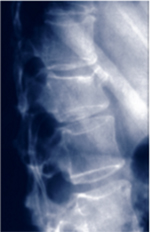 |
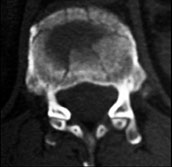 |
| Vertebra treated with kyphoplasty. The repositioning of the fracture is noticeable |
 |
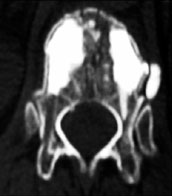 |
| View during surgery The moment of inserting the balloon and then injecting the cement in a patient with a tumor of the column |
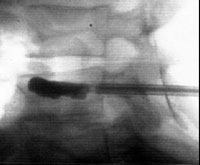 |
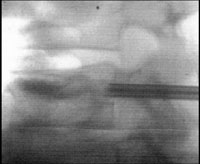 |
| Osteoporotic fracture. Filling the vertebral body repositions the fractures and removes the pain. |
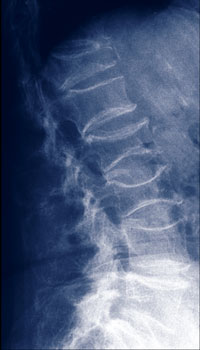 |
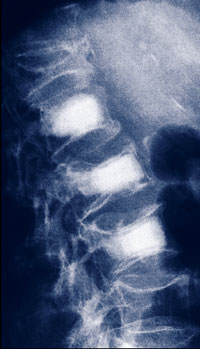 |
- Thoracolumbar burst fractures: a systematic review of management. Alpantaki K, Bano A, Pasku D, Mavrogenis AF, Papagelopoulos PJ, Sapkas GS, Korres DS, Katonis P. Orthopedics. 2010 Jun;33(6):422-9. doi: 10.3928/01477447-20100429-24. Review.
- Treatment of pathologic spinal fractures with combined radiofrequency ablation and balloon kyphoplasty. Katonis P, Pasku D, Alpantaki K, Bano A, Tzanakakis G, Karantanas A. World J Surg Oncol. 2009 Nov 16;7:90. doi: 10.1186/1477-7819-7-90.
- Pflugmacher R, Beth P, Schroeder RJ, Schaser KD, Melcher I. Balloon kyphoplasty for the treatment of pathological fractures in the thoracic and lumbar spine caused by metastasis: one-year follow-up. Acta Radiol.2007;48:89–95. doi: 10.1080/02841850601026427. [PubMed] [Cross Ref]
- Lieberman IH, Dudeney S, Reinhardt MK, Bell G. Initial outcome and efficacy of "kyphoplasty" in the treatment of painful osteoporotic vertebral compression fractures. Spine. 2001;26:1631–8. doi: 10.1097/00007632-200107150-00026. [PubMed] [Cross Ref]
- Rao RD, Singrakhia MD. Painful osteoporotic vertebral fracture: Pathogenesis, evaluation, and roles of vertebroplasty and kyphoplasty in its management. J Bone Joint Surg Am. 2003;85:2010–22. [PubMed]
- Khanna AJ, Neubauer P, Togawa D, Kay Reinhardt M, Lieberman IH. Kyphoplasty and vertebroplasty for the treatment of spinal metastases.Supportive Cancer Therapy. 2005;3:21–25. doi: 10.3816/SCT.2005.n.021.[PubMed] [Cross Ref]
- Dudeney S, Lieberman IH, Reinhardt MK, Hussein M. Kyphoplasty in the treatment of osteolytic vertebral compression fractures as a result of multiple myeloma. J Clin Oncol. 2002;20:2382–7. doi: 10.1200/JCO.2002.09.097.[PubMed] [Cross Ref]
- Hadjipavlou AG, Tzermiadianos MN, Katonis PG, Szpalski M. Percutaneous vertebroplasty and balloon kyphoplasty for the treatment of osteoporotic vertebral compression fractures and osteolytic tumours. J Bone Joint Surg Br.2005;87:1595–604. doi: 10.1302/0301-620X.87B12.16074. [PubMed][Cross Ref]
- Taylor RS, Fritzell P, Taylor RJ. Balloon kyphoplasty in the management of vertebral compression fractures: an updated systematic review and meta-analysis. Eur Spine J. 2007;16:1085–100. doi: 10.1007/s00586-007-0308-z.[PMC free article] [PubMed] [Cross Ref]
- Pflugmacher R, Taylor R, Agarwal A, Melcher I, Disch A, Haas NP, Klostermann C. Ballon kyphoplasty in the treatment of metastatic disease of the spine: a 2-year prospective evaluation. Eur Spine J. 2008;17:1042–48. doi: 10.1007/s00586-008-0701-2. [PMC free article] [PubMed] [Cross Ref]
- Barrocas AM, Eskey CJ, Hirsch JA. Vertebral augmentation in osteoporotic fractures. Injury. 2007;38:88–96. doi: 10.1016/j.injury.2007.08.016.[PubMed] [Cross Ref]
- Liu JT, Liao WJ, Tan WC, Lee JK, Liu CH, Chen YH, Lin TB. Balloon kyphoplasty versus vertebroplasty for treatment of osteoporotic vertebral compression fracture: a prospective, comparative, and randomized clinical study. Osteoporos Int. 2009. in press . [PubMed]
- Nakatsuka A, Yamakado K, Maeda M, Yasuda M, Akeboshi M, Takaki H, Hamada A, Takeda K. Radiofrequency ablation combined with bone cement injection for the treatment of bone malignancies. J Vasc Interv Radiol.2004;15:707–12. [PubMed]